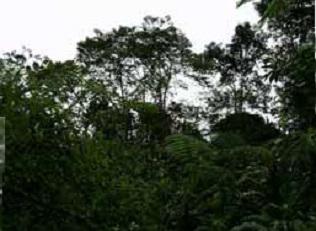Wim Ikbal
This project is comprised by two main activities, i.e. population, habitat surveys and spatial (GIS) analysis.

A member of isolated javan-gibbon family.
This project is aimed to improve the design new zonation of Gunung Halimun-Salak National Park by providing the Management Authority with accurate and updated spatial information on Javan gibbon distribution and potential habitat in Gunung Salak Area. Although the zonings are determined by considering many natural and social factors, the information of distribution of Java Gibbons is essential for the zonings because Java Gibbon is one of the keystone species of the lowland and montane tropical forest ecosystem in addition to it is a critically endangered species (Eudey and MPSG2000, 2004). In fact, currently the park manager has a lack information on Javan gibbon distribution in expanded areas, including Mt Salak.

Degraded habitat in study area.
This project is comprised by two main activities, i.e. population, habitat surveys and spatial (GIS) analysis. Javan gibbon distribution and its habitat structure will be acquired by conducting the first activity for spatial model development and validation. The surveys will be carried out on three selected sites, i.e. Cangkuang (Cidahu), Bobojong (Taman Sari), and geothermal power planting areas (Parakansalak). Potential habitat suitability classes map will be generated by the second activity. This map is actually is the induction from the spatial model. The spatial model is developed based on the accumulation of knowledge of Javan gibbon on its response to habitat structure.
The information generated by this project will be used as a scientific basis to implement the strategic action recommended by The Working Group of Javan Gibbon and Langur Population in The Habitat Viability Analysis Workshop (1994) and The Action Plan for the Endangered Species Conservation in Gunung Halimun-Salak National Park (2003).